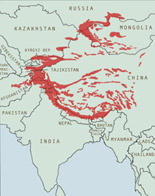Snow leopard numbers and habitat in India
Snow leopards occur in the Himalayan and Trans-Himalayan areas of five states in northern India. The total range is estimated to cover 126,842 square kilometres. The five states are Jammu & Kashmir, Himachal Pradesh, Uttarakhand, Sikkim and Arunachal Pradesh.
Snow leopards are found in the subalpine and alpine zones above 3,200 m in the west and c. 4,200 m in the east. The current estimate of snow leopard population size in India is 400-700. (Snow Leopard Survival Strategy 2014.1).
Snow leopards occur in around 20 protected areas but range across non protected landscapes as well.
Threats to snow leopards in India
The latest information identifies these threats as high for snow leopards in India.
- Habitat degradation
- Prey reduction due to competition with lievstock
- Retaliation for livestock depredation
- Prey reduction due to disease
- Fencing that disrupts movement
- Diseases of snow leopards
- Lack of appropriate policies
- Lack of effective enforcement a
- Lack of institutional capacity
- Lack of knowledge of local people and policy makers
- Feral dogs attacking snow leopards and prey
- Climate change
- Large infrastructure development
Conservation Action
Snow Leopard Conservancy (SLC) and Snow leopard Conservancy – India Trust (SLC -IT)
Both the SLC and the SLC -IT have developed research and community-based snow leopard education programs in Ladahk in the state of jammu and Kashmir.
The Homestay program is a ground breaking ecotourism approach where local people host tourists, many of them foreign nationals, in Ladakhi homes which gives them a chance to enjoy traditional hospitality, food and culture. The SLC also gives technical and financial help to tourism activities if no snow leopard or cubs are killed by the villagers.
In order to help stop livestock retaliation killings the SLC has over many years helped build predator proof pens for sheep and goats so that snow leopards are not able to get access to these animals. Decreases in losses of domestic stock to snow leopards leads to less retaliation killings. All these programs are helping people and snow leopards live side by side.
Ministry of Environment and Forests India
Indian government and NGO conservation agencies launched ‘Project Snow Leopard’ in 2009 to help protect the high altitudes of India’s Himalayas with its highly endangered populations of species such as snow leopard, black-necked crane, bears, and endangered wild sheep and goats.
The mission of Project Snow Leopard is to “safeguard India’s unique natural heritage of high altitude wildlife populations and their habitats by promoting conservation through participatory policies and actions in important landscapes in the Himalayan high altitudes.
Snow Leopard Trust and Nature Conservation Foundation India
The Snow Leopard Trust first began working in India in 1998 with their partner the Nature Conservation Foundation (NCF) .
Local communities are reliant on their domestic sheep and goats. It can be a huge economic hardship if a snow leopard kills any of these animals. The SLT has initiated livestock insurance programs which help communities by giving them compensation when they lose livestock to snow leopard predation.
The livestock insurance program works on the basis that order to participate, each herder must sign a conservation agreement in which they pledge to protect the snow leopards. In some regions communities have also agreed to leave more food for the snow leopard’s wild prey by setting aside graze-free areas.
The SLT also runs remote camera trap research in India whereby teams set up cameras which take a picture every half-second when a source of heat in a body of a snow leopard or any other animal moves in front of it. Data from these photos can identify snow leopard numbers, individual cats as well as identify the type of prey animals sharing the snow leopard’s habitat.



